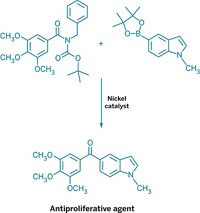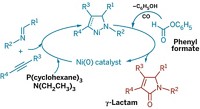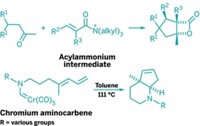Advertisement
Grab your lab coat. Let's get started
Welcome!
Welcome!
Create an account below to get 6 C&EN articles per month, receive newsletters and more - all free.
It seems this is your first time logging in online. Please enter the following information to continue.
As an ACS member you automatically get access to this site. All we need is few more details to create your reading experience.
Not you? Sign in with a different account.
Not you? Sign in with a different account.
ERROR 1
ERROR 1
ERROR 2
ERROR 2
ERROR 2
ERROR 2
ERROR 2
Password and Confirm password must match.
If you have an ACS member number, please enter it here so we can link this account to your membership. (optional)
ERROR 2
ACS values your privacy. By submitting your information, you are gaining access to C&EN and subscribing to our weekly newsletter. We use the information you provide to make your reading experience better, and we will never sell your data to third party members.
Synthesis
Renewed Focus On A Neglected Reaction
Synthesis: New Diels-Alder route to complex benzenoids
by Stu Borman
October 15, 2012
| A version of this story appeared in
Volume 90, Issue 42

Researchers have found that a known cycloaddition reaction has not been living up to its potential. The finding could lead to more efficient syntheses of drugs, natural products, heteroaromatics, polyacenes, and other compounds.
The reaction is the Diels-Alder cycloaddition of an alkyne and diyne. Natural products specialist Thomas R. Hoye and coworkers at the University of Minnesota rediscovered serendipitously that mild heating of a starting material containing alkyne and diyne groups induces intramolecular Diels-Alder cycloaddition to benzyne, which is then trapped—for example, by an internal t-butyldimethylsiloxy group—to give polycyclic benzenoid products (Nature, DOI: 10.1038/nature11518).
The Hoye group also found that the benzyne intermediate can, in the absence of an internal trapping agent, react intermolecularly with reagents like alcohols, amides, halides, or acids to form complex benzenoids. They propose that the process that generates the reactive benzyne be renamed the hexadehydro-Diels-Alder (HDDA) reaction.
The first clear examples of the HDDA reaction were reported in 1997 by organic chemist Richard P. Johnson’s group at the University of New Hampshire and independently by organic chemist Ikuo Ueda and coworkers at Osaka University, in Japan. Recently, Brian T. Sterenberg’s group at the University of Regina, in Saskatchewan, reported a metal-templated version. But chemists have rarely used the reaction or exploited it for synthetic purposes.
What is most novel in the current study “is the beautiful intramolecular trapping by a proximate protecting group and a wide variety of intermolecular benzyne-trapping agents,” Johnson comments. “This is an important paper that may help a spectacular but long overlooked type of cycloaddition find its way into the synthetic lexicon.”
The work shows that the HDDA reaction, “previously primarily a curiosity, has significant synthetic applications,” says Sterenberg. “The relatively easy precursor synthesis along with the potential for further elaboration means that the reaction will find applications in the synthesis of complex polycyclic organic products. This paper will have a significant impact on the field of organic synthesis.”





Join the conversation
Contact the reporter
Submit a Letter to the Editor for publication
Engage with us on Twitter